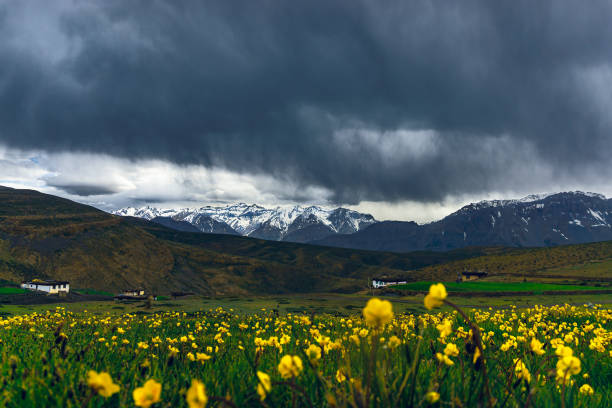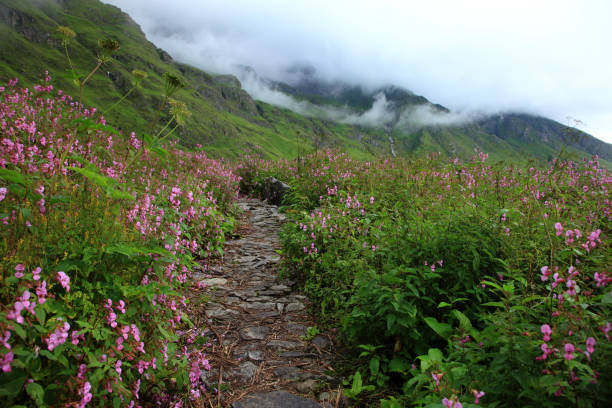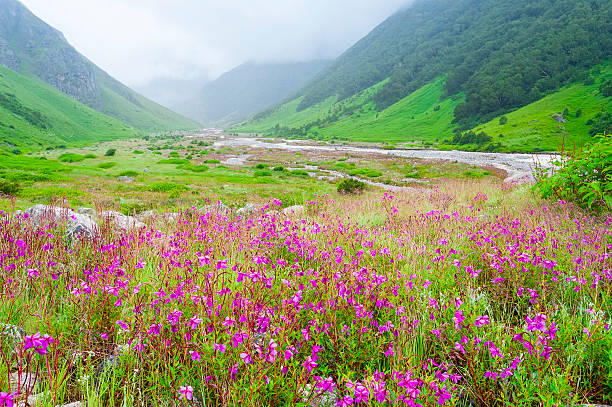
Exploring the Enchanted Valley of Flowers in Uttarakhand
Introduction :
The Valley of Flowers, located in the Chamoli district of Uttarakhand, is celebrated for its unparalleled natural beauty and exceptional biodiversity. Encompassing an area of about 87.5 square kilometers, this pristine valley is ensconced amidst the towering peaks of the Western Himalayas, including Nanda Devi and Kamet. The valley is a high-altitude glacial basin, snow-covered during the winter months, and bursting into a riot of colors during the summer monsoon.The Valley of Flowers in Uttarakhand is a true marvel of nature.

History and Conservation
The history of the Valley of Flowers is as intriguing as its landscape. In 1931, British mountaineer Frank S. Smythe discovered the valley quite by accident. His book, “The Valley of Flowers,” helped introduce this hidden gem to the world. The region was subsequently declared a national park in 1982 and later recognized as a UNESCO World Heritage Site in 2005. Its conservation has since become a top priority, and visitors are required to obtain permits to enter.
The valley’s unique ecosystem is vulnerable, and every precaution is taken to preserve its delicate balance. Commercial activities and camping are restricted to certain areas, and trekkers are required to adhere to strict environmental guidelines. The region’s conservation efforts serve as a model for sustainable tourism and environmental protection.
Heaven for nature lover
The Valley of Flowers, situated in the Chamoli district of Uttarakhand, is renowned for its unparalleled natural beauty and exquisite biodiversity. Covering an area of approximately 87.5 square kilometers, this pristine valley is enveloped by the towering peaks of the Western Himalayas, including Nanda Devi and Kamet. The valley is a high-altitude glacial basin that remains snow-covered during the winter months and bursts into a riot of colors during the summer monsoon.

Flora and Fauna: What sets the Valley of Flowers apart is its remarkable floral diversity. More than 650 species of wildflowers, including the stunning blue poppy, the exotic orchids, and the rare Brahma Kamal, can be found here. It’s a breathtaking kaleidoscope of colors as the valley comes alive with vibrant blossoms during the brief summer months. Each flower seems to have its own unique story, and botanists from around the world flock to this region to study its extraordinary flora.
The valley isn’t just about flowers, though. It’s also a sanctuary for diverse wildlife, including the Himalayan musk deer, snow leopard, red fox, and a wide variety of bird species. If you’re lucky, you might catch a glimpse of one of these elusive creatures while exploring the trails that crisscross the valley.
When to Visit
The best time to visit the Valley of Flowers is during the monsoon season, from late July to early September. During this time, the valley bursts into a riot of colors as the various species of wildflowers bloom. The weather is generally pleasant, but be prepared for occasional rain showers. The park remains closed during the winter months when heavy snowfall makes it inaccessible.
Exploring the Valley
To explore the Valley of Flowers, you can embark on a trek that begins in the small town of Govindghat, which is the gateway to the valley. The trek usually takes 4-5 days to complete, covering a distance of around 17 kilometers. The trail leads you through lush forests, meadows, and streams, offering breathtaking views of the surrounding mountains. You can hire a local guide to enhance your experience and learn more about the region’s flora and fauna.
NEAR BY DESTINATIONS
Must-See Spots :
Ghangaria: This is the base camp for trekkers and is situated about 13 kilometers from Govindghat. It’s a charming place with a few hotels, restaurants, and shops.
Hemkund Sahib: A revered Sikh shrine, Hemkund Sahib is a short trek from Ghangaria and offers a serene and spiritual experience. The pristine lake and the gurudwara nestled amidst the mountains are truly awe-inspiring.
Pushpawati River: The crystal-clear waters of the Pushpawati River flow through the valley, and it’s an ideal spot to relax and take in the beauty of the surroundings.
Tula Kharak: This high-altitude meadow offers panoramic views of the valley, and it’s a great place to capture the stunning landscapes with your camera.
Tipra Glacier: If you’re up for more adventure, you can extend your trek to Tipra Glacier, which is a source of the Pushpawati River. The glacier is surrounded by majestic peaks and is a sight to behold.

Acclimatization: Due to the high altitude, it’s essential to spend a day in Ghangaria to acclimatize before heading into the valley.
Permits: Make sure to obtain the necessary permits and check the opening dates of the park before planning your trip.
Packing: Dress in layers and carry appropriate gear for unpredictable weather conditions, as well as essential items like rain gear, sunscreen, and a good pair of trekking shoes.
Leave No Trace: Follow the “leave no trace” principle by not disturbing the local flora and fauna and by cleaning up after yourself.
Tips for Visiting
Acclimatization: Due to the high altitude, it’s essential to spend a day in Ghangaria to acclimatize before heading into the valley.
Permits: Make sure to obtain the necessary permits and check the park’s opening dates before planning your trip.
Packing: Dress in layers and carry appropriate gear for unpredictable weather conditions, along with essential items like rain gear, sunscreen, and sturdy trekking shoes.
Leave No Trace: Adhere to the “leave no trace” principle by not disturbing the local flora and fauna and cleaning up after yourself.

Conclusion :The Valley of Flowers in Uttarakhand is a true marvel of nature. Its breathtaking landscapes, diverse flora and fauna, and rich history make it a destination that every nature lover and adventure enthusiast should experience at least once in their lifetime. But remember, with its fragile ecosystem, responsible tourism is the key to preserving this enchanting valley for generations to come. So, plan your visit, immerse yourself in its beauty, and leave with a renewed appreciation for the wonders of the natural world.
Frequently Asked Questions
The Valley of Flowers is a high-altitude glacial basin located in the Chamoli district of Uttarakhand, India. It is renowned for its stunning floral diversity and pristine natural beauty, earning it recognition as a UNESCO World Heritage Site.
The best time to visit the Valley of Flowers is during the monsoon season, typically from late July to early September. This is when the valley bursts into a riot of colors as numerous species of wildflowers bloom.
You can reach the Valley of Flowers by starting your journey in Govindghat, a small town that serves as the gateway to the valley. From there, you can trek to Ghangaria, which is the base camp for visitors heading to the valley. A further trek of around 17 kilometers leads you into the heart of the Valley of Flowers.
The trekking distance from Ghangaria to the Valley of Flowers is approximately 3 kilometers, one way. It’s a moderately challenging trek, but the stunning scenery along the way makes it worthwhile.
Yes, hiring a local guide is a great idea for your trip. Local guides are knowledgeable about the region’s flora and fauna and can enhance your experience by providing valuable insights.
- You might be interested in reading this post as well.
- Uttarakhand History

